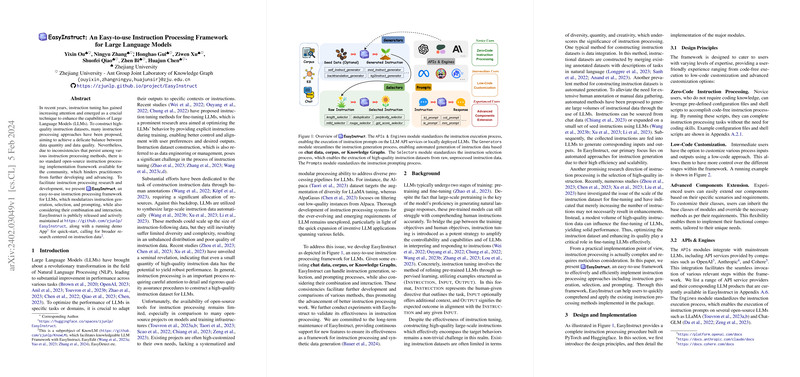Overview of "EasyInstruct: An Easy-to-use Instruction Processing Framework for LLMs"
Introduction
The paper introduces EasyInstruct, an instruction processing framework tailored for LLMs. As instruction tuning is pivotal in optimizing LLM performance, EasyInstruct addresses the need for a standardized, modular approach to instruction processing. Despite various proposed methods for instruction set creation, inconsistencies exist, often complicating broader research and application in the field. EasyInstruct aims to streamline this by modularizing components such as instruction generation, selection, and prompting, while also enabling their integration.
Design and Implementation
Design Principles
EasyInstruct is structured to cater to a spectrum of users, from novices to experts, by offering:
- Zero-Code Instruction Processing: Non-programmers can utilize predefined configurations and scripts for a code-free experience.
- Low-Code Customization: Intermediate users can modify inputs and outputs with minimal coding.
- Advanced Component Extension: Experienced users can extend and customize base classes to suit specific needs.
Major Components
- APIs and Engines: The framework integrates with major LLM services like OpenAI and Cohere, and supports execution on open-source LLMs like LLaMA, ensuring robust instruction execution processes.
- Generators: This module facilitates automated instruction generation, leveraging different seed sources:
- Chat Data: Implements methods like Self-Instruct, allowing generation of new instructions from seed tasks.
- Corpus: Methods like Backtranslation predict instructions based on corpus paragraphs.
- Knowledge Graphs: Generates instruction datasets for Information Extraction tasks, merging existing knowledge graphs with instruction templates.
- Selectors: Central to curating high-quality instruction datasets, this module evaluates instructions using various metrics, such as lexical diversity and model-based scoring.
- Prompts: This component standardizes instruction prompting, ensuring consistent interaction with LLMs. It supports techniques such as Chain-of-Thought and Information Extraction.
Evaluation
The framework's efficacy was tested by creating and refining several datasets using EasystInstruct’s capabilities:
- Datasets like self_instruct_5k and easyinstruct_5k demonstrated significant improvements in model performance during evaluation on AlpacaFarm.
- The paper of dataset diversity illustrated a broad range of verb-noun structures in instructions, indicating high variability and richness.
- A qualitative case paper showed a selection of high-quality, logically coherent instructions.
Implications and Future Directions
EasyInstruct, by combining instruction generation, selection, and prompting into a cohesive framework, accelerates the development of LLM applications. It enhances the quality and efficiency of instruction data synthesis, offering significant practical benefits in fine-tuning LLMs across various domains.
The framework’s open-source nature encourages continuous improvements and extensions. Future developments could include enhancements for knowledge-intense data generation, further broadening its applicability. Additionally, as LLMs evolve, EasyInstruct could integrate advancements in multimodal instruction processing.
In conclusion, EasyInstruct equips researchers and practitioners with a powerful tool for effective instruction processing, paving the way for more sophisticated and refined uses of LLMs. Predictably, its adoption will spur further innovations and applications within the AI community.
